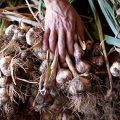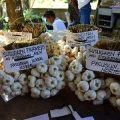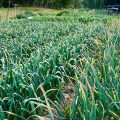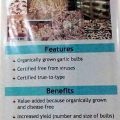Can you imagine not putting garlic or onion in any of your food? I imagine that soups, stews, and casseroles wouldn’t be as delectable, aromatic, and appetizing. But can you imagine if these high value crops are no longer planted in Philippine soils?
There was a time when onion and garlic were produced abundantly in the country, meeting the demands of both the local and international markets. However, the decline in local production and the influx of cheap imports from neighboring countries in the past years saw the downturn of onion and garlic industry in the country.

Winning research
The Ilocos region leads in the production of garlic and onion in the country. However, with the rising cost of fertilizers and prevalence of pests, and add the imported produce sold at much lower prices are disappointing the farmers of Ilocos Norte and Ilocos Sur.
In a bid to revive the garlic and onion production of the region and sustain the livelihood of the farmers, scientists and researchers of DA-Regional Field Unit 1 (RFU 1) and Don Mariano Marcos Memorial State University (DMMMSU) in Bacnotan, La Union joined hands to commercialize new technologies that will increase the efficiency and yield and income of farmers by at least 15-20%.
The research made by Wilhelmina Castañeda, Leticia Bensan, Edmundo Quinit, and Benjamin Ronduen on garlic and onion technology commer-cialization earned top recognition in last year’s National Research Symposium. Their study showed that the technology of using processed chicken manure (PCM) with giberellic acid (GA3) gives higher yield and income compared to the usual fertilization practice of farmers in the Ilocos region.
Learning by doing
In order to facilitate the adoption of technology, the DA-RFU 1 purchased the growth hormone, Berelex, and other farm inputs. They also developed a facility wherein materials would be given as loans with 50 percent subsidy, plus a free flyer containing the step-by-step procedure of the technology. The farmers would repay these after a month’s harvest.
A field demonstration was conducted so that the farmers would have first-hand experience on learning the proper methods of seed sowing for garlic and transplanting for onion as well as the application of inorganic and microbial fertilizers (vital N and Bio N). They were also given a chance to discuss and compare the results of the technologies. The interaction proved to be the venue for exposing the fallacy that applying big amounts of fertilizer shall result to higher yield and income.
Points of success
Results of the Region I study showed that the application of 50+15+45 kg NPK ha with ten bags PCM sprayed with 4 tablets GA 3 /ha in 2 split application at 36 and 56 DAP, gave higher yield and income by 29 percent and 83 percent, respectively, than the farmer’s practice. It was also found that the best garlic is produced in Pasuquin, Ilocos Norte with cool and windy climate throughout the growing period, and sandy loam textured soil that favors better growth and development of the bulbs. However, it was advised that garlic should not be grown along with onion since the bulbs will be highly susceptible to thrips.
Promoting GA 3 technology
Recently, the group of Ms. Castañeda participated in the Technology Forum organized by the Bureau of Agricultural Research (BAR). Ms. Castañeda presented the technology of using GA 3 for garlic. She explained that GA 3 is a hormone that promotes plant growth and development and its proper use can indeed increase the yield of farmers. The commonly used GA 3 is commercially available as Berelex.
Applying the GA 3
According to Ms. Castañeda, to apply the gibberellic acid, 1/4 tablet Berelex should be mixed with 16 liters of water in a sprayer tank. The soil should be moist before spraying. She said that one tank mixture is enough to spray 2,500 sq m farm using a single low volume sprayer nozzle. This should be sprayed at the growing tissues or on young leaves late in the afternoon at 36 and 56 DAP for optimum results.
She noted that garlic grows best in sandy loam to silt loam soils with a pH of 5.5 to 6.5 and is well adapted to areas with Type 1 climate (with the wet season from May to October and the dry season from November to April). Also, in order to establish the crop, she said that garlic should be planted in a well-drained and medium textured soil to avoid water logging. She advised the use of integrated pest management approaches to control the growth of pests. However, the effectiveness of GA 3 still depends on the right timing and amount of application, and growth requirements of garlic.
by Miko Jazmine J. Mojica, BAR Chronicle, May 2005 Issue (Vol. 6 No. 5)






